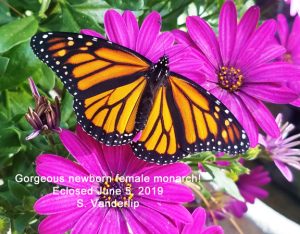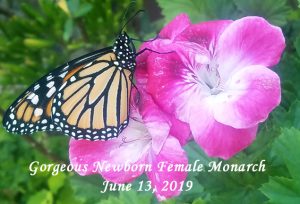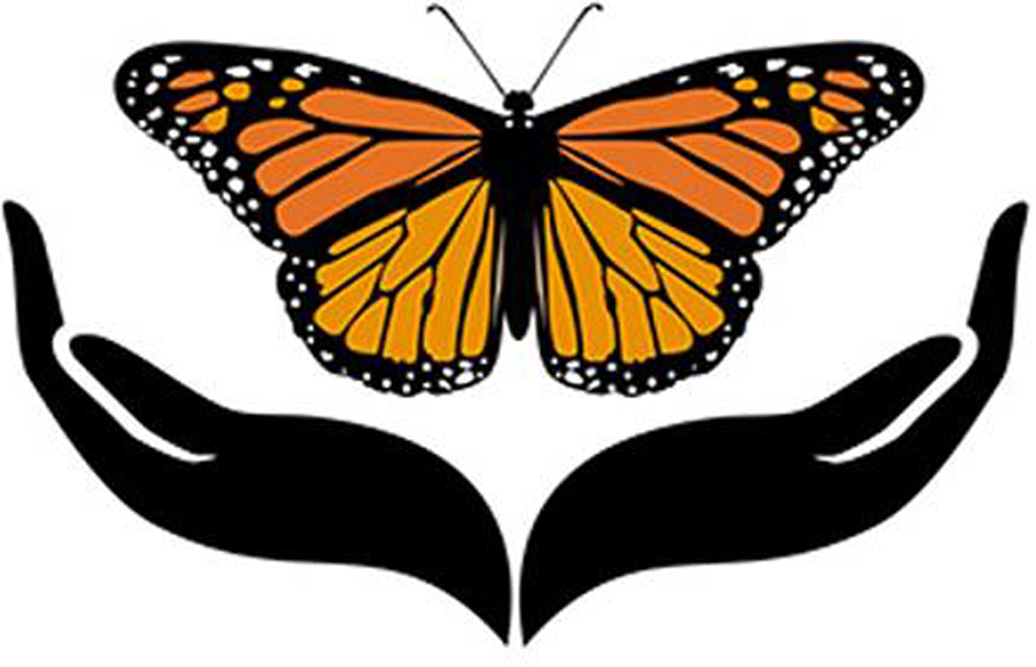
18 Jan First WESTERN MONARCH SUMMIT, Carmel, California – Jan 10-12, 2020
On Friday, January 10th thru Sunday, January 12th, 2020, I had the delight of attending the first ever Western Monarch Summit coordinated by Western Monarch Advocates and the apt leadership Chair Robert Coffan. It was held in Carmel, California and was, for me, a profound experience! I have been passionately raising, writing, photographing, videotaping and speaking on monarchs for the last ten years and, though a monarch butterfly citizen scientist, this was the first time I heard in person lectures and research results from the nation’s premiere experts in monarch butterflies from the most prestigious non-profits and university programs I have read about and followed online for 10 years!
 I met and heard Dr. Chip Taylor speak, Founder of Monarch Watch, University of Kansas in 1992 which continues today to provide a variety of excellent programs to support all of us home garden
I met and heard Dr. Chip Taylor speak, Founder of Monarch Watch, University of Kansas in 1992 which continues today to provide a variety of excellent programs to support all of us home garden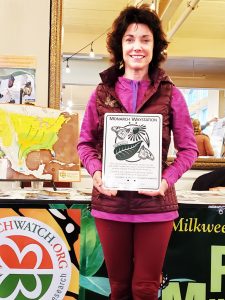 ers eager to help save the monarchs. See several of their services below – from helping guide us to plant Monarch Waystations in our gardens to buying native milkweed and more. (http://www.monarchwatch.org )
ers eager to help save the monarchs. See several of their services below – from helping guide us to plant Monarch Waystations in our gardens to buying native milkweed and more. (http://www.monarchwatch.org )
I heard Dr. Robert ‘Bob’ Pyle, founder of the Xerces Society, 1971 (http://www.xerces.org ) speak on How Our Eastern and Western Monarchs Blend. Xerces is a non-profit for western monarchs and a milkweed seed source. (http://www.xerces.org/milkweed/milkweed-seed-finder )
Matt Forister, Ph.D., University of Reno, spoke on Understanding the Monarch with a Declining Regional Fauna. Dr. Cheryl Schultz, Washington State, spoke on Western Monarch Population Viability Analysis (can they survive?) Joel Trumbo of WAFWA (Western Association of Fish and Wildlife Agencies) shared about the new 50 Year Western Monarch Conservation Plan (2019 to 2069). Dr. David James spoke on Neonicotinoid Insecticides a major factor in Monarch Population Decline? Dr. Karen Oberhauser, Director of UW-Madison Arboretum and the Monarch Larva Monitoring Project spoke on Citizen Science – an important contribution we local gardeners can make by providing data to university research. And Katie-Lyn Bunney, Education Coordinator for Monarch Joint Venture – yet another excellent resource of information on all things monarch: Habitat, Education, Science, Partnerships. (http://www.monarchjointventure.org)
Two and a half days of amazing INFO THAT IMPACTS SOUTHERN CALIFORNIA GARDENERS!
For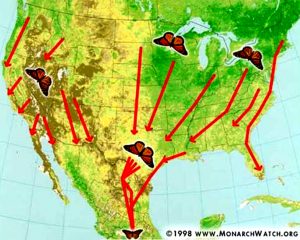 a perspective on our western monarchs: Research and events pertaining to monarchs has predominately focused on the eastern monarchs in past. The eastern monarchs are those millions of butterflies that do the three-thousand-mile migration down to Michoacán, Mexico to overwinter (semi-hibernate) in the oyamel fir trees for months every year, waiting out the winter snows until the spring thaw. The western monarchs are those born in the western states of Idaho, Washington, Oregon, California, Utah, Nevada and some from Arizona that migrate to central coast California to overwinter. Western monarch roosting sites (roosting = large groups of monarchs that cluster and hang together in trees while sleeping through the winter months) include several dozen locations from Goleta to Monterey, with largest site at Pismo State Beach Monarch Grove. In central coast California, many roost in Eucalyptus trees.
a perspective on our western monarchs: Research and events pertaining to monarchs has predominately focused on the eastern monarchs in past. The eastern monarchs are those millions of butterflies that do the three-thousand-mile migration down to Michoacán, Mexico to overwinter (semi-hibernate) in the oyamel fir trees for months every year, waiting out the winter snows until the spring thaw. The western monarchs are those born in the western states of Idaho, Washington, Oregon, California, Utah, Nevada and some from Arizona that migrate to central coast California to overwinter. Western monarch roosting sites (roosting = large groups of monarchs that cluster and hang together in trees while sleeping through the winter months) include several dozen locations from Goleta to Monterey, with largest site at Pismo State Beach Monarch Grove. In central coast California, many roost in Eucalyptus trees.
IMPORTANT NOTE: Eastern and western monarchs have highly similar DNA. They are the same species; they just take different migratory routes based upon where they are born.
RECENTLY DISCOVERED: Arizona monarchs can be choosy – some migrate to central coast, California, some south to Mexico. Here, eastern and western monarchs mix.
This migration of monarchs is one of the great wonders of the insect world!
Monarch COUNTS:
And every year, monarch citizen scientists and researchers to a monarch count at Thanksgiving, counting the number of monarchs at the various roosting sites.
Here’s the bad news: Twenty years ago, 1 billion eastern monarchs overwintered in Mexico. Now there are around 98 million, a loss of 80%. Twenty years ago, 1.5 million western monarchs overwintered in central coast California. Last year there were a mere 27,000 – making monarch researchers question if they are at extinction level.
The Summit focused on these disturbing counts. And here I’ll summarize what I learned from the nation’s experts.
Monarchs have declined over the last 20 years due to these factors:
1. Pesticide use –Current research has begun to indicate that neonicotinoids (aka neonics) and glyphosate (aka RoundUp) made by Bayer, Syngenta and Monsanto are impacting the decline. Neonics are one of 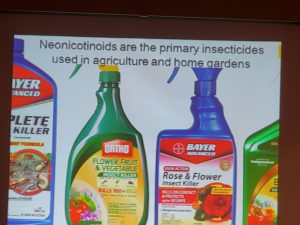 the most common pesticides used in agriculture and extensively by home and garden centers. Unbeknownst to consumers, many bee and butterfly friendly plants have been pre-treated with these pesticides and the very plants meant to nurture bees and butterflies will then kill them or their larvae.
the most common pesticides used in agriculture and extensively by home and garden centers. Unbeknownst to consumers, many bee and butterfly friendly plants have been pre-treated with these pesticides and the very plants meant to nurture bees and butterflies will then kill them or their larvae.
Glyphosate is the most widely used herbicide in the world. In the US, it is wiping out milkweed which monarch butterflies rely on for their caterpillars to eat.
Use of these has increased dramatically in the past two decades since Monsanto launched its genetically engineered Roundup-Ready corn, soy, canola and cotton.
The European Union suspended use of three neonics after a scientific review found they pose an unacceptably high risk to bees. In contrast, the EPA has been dragging its feet. Despite receiving more than six million public comments urging swift protection for bees, the agency has delayed action to this day. (Thanks to Friends of the Earth for additional info here.)
(More on Pesticide details in upcoming blogs as research continues on the impact of neonics on monarch decline.)
2. Habitat Loss for Propagation
Habitat loss has occurred due to agriculture plowing under native milkweed and native nectar plants and urbanization of many areas with landscaping that has, until recently, not included natives. Remember, milkweed is the host plant for monarchs. It is the only plant their caterpillars/larvae will eat. Eliminate milkweed, and no monarchs.
3. Global Warming
Drought caused by global warming contributed to many of the roosting eucalyptus trees to die or fall over. Without roosting trees, monarchs won’t survive the winter months to wake up and reproduce in mid-February to March.
Accordingly, to Dr. Angela Laws, 50 roosting sites in California have been lost in recent years. 12 sites were lost just last year in 2018.
In addition, Matt Forestor shared that drought and warming summers cause a decline in nectar plants. Milkweed and native nectar plants need to be available and blooming at proper stages of monarch development over four generations each year. Global warming throws off the timing and reduces availability, reducing the number of eggs that hatch and caterpillar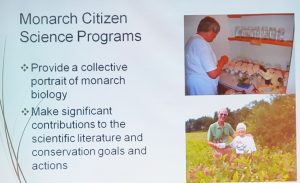 s that survive to pupate into monarchs.
s that survive to pupate into monarchs.
As you can see, our dear monarchs have a lot of serious challenges.
SOUTHERN CALIFORNIA GARDENERS UNITE!
Plan to create a Monarch Waystation in your garden this spring! Why not become a Monarch Butterfly Citizen Scientist? See my blog on how easy it is to do, or email me and arrange a training. You can create a Monarch Waystation on a small patio or an acre of land. Regardless, we can all plant Milkweed and nectar plants to nourish monarchs!
Learn more below from MONARCH WATCH PROGRAMS (http://www.monarchwatch.org )
1. MONARCH WAYSTATIONS https://www.monarchwatch.org/waystations/
To offset the loss of milkweeds and nectar sources we need to create, conserve, and protect monarch butterfly habitats. You can help by creating “Monarch Waystations” (monarch habitats) in home gardens, at schools, businesses, parks, zoos, nature centers, along roadsides, and on other unused plots of land. Creating a Monarch Waystation can be as simple as adding milkweeds and nectar sources to existing garden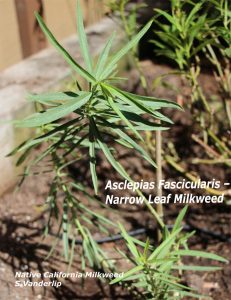 s or maintaining natural habitats with milkweeds. No effort is too small to have a positive impact.
s or maintaining natural habitats with milkweeds. No effort is too small to have a positive impact.
Be sure to register your habitat(s) to receive your certificate and encourage others to follow in your footsteps!
2. Monarch Watch Milkweed Market
https://shop.milkweedmarket.org/
Order native milkweeds for your area. These native plants are grown in a wholesale restoration nursery, not in a retail nursery.
3. Free Milkweeds for Schools & Non-Profits
https://monarchwatch.org/bring-back-the-monarchs/milkweed/free-milkweeds-schools-nonprofits/
4. Free Milkweeds for Restoration Projects
Free milkweeds are for large-scale (two acres or more) native habitat restoration only.
https://monarchwatch.org/bring-back-the-monarchs/milkweed/free-milkweeds-for-restoration-projects/
5. Read more from Dr. Chip Taylor’s Blog
https://monarchwatch.org/blog/
Monarch Population Status
17 November 2019 | Author: Chip Taylor
Why overwintering monarch numbers will be lower this year
Please feel free to share this blog with everyone you can to encourage PLANTING WAYSTATIONS THIS SPRING!
Contact me with any questions: Susie@storyofchester.com
